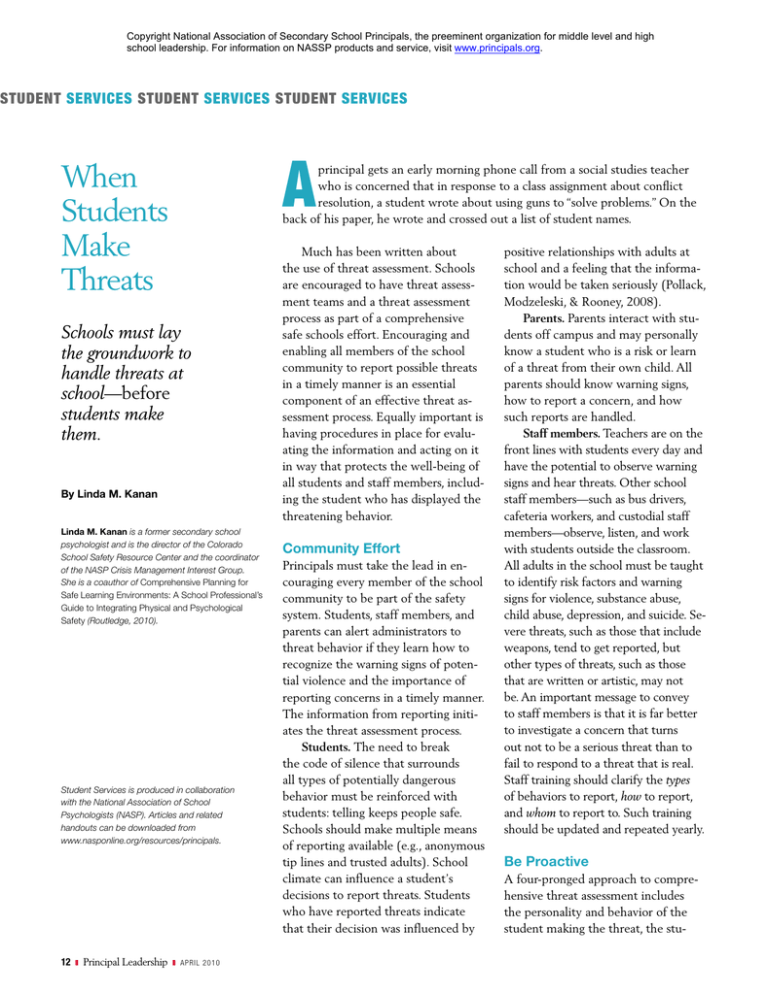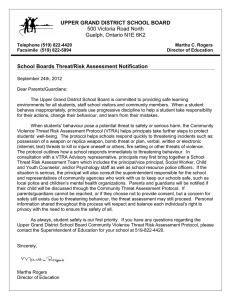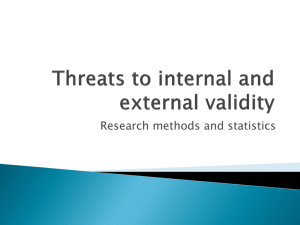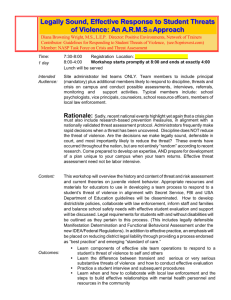A When
advertisement

Copyright National Association of Secondary School Principals, the preeminent organization for middle level and high school leadership. For information on NASSP products and service, visit www.principals.org. student services student services student services A When Students Make Threats principal gets an early morning phone call from a social studies teacher who is concerned that in response to a class assignment about conflict resolution, a student wrote about using guns to “solve problems.” On the back of his paper, he wrote and crossed out a list of student names. Schools must lay the groundwork to handle threats at school—before students make them. By Linda M. Kanan Linda M. Kanan is a former secondary school psychologist and is the director of the Colorado School Safety Resource Center and the coordinator of the NASP Crisis Management Interest Group. She is a coauthor of Comprehensive Planning for Safe Learning Environments: A School Professional’s Guide to Integrating Physical and Psychological Safety (Routledge, 2010). Student Services is produced in collaboration with the National Association of School Psychologists (NASP). Articles and related handouts can be downloaded from www.nasponline.org/resources/principals. 12 z Principal Leadership z april 2010 Much has been written about the use of threat assessment. Schools are encouraged to have threat assessment teams and a threat assessment process as part of a comprehensive safe schools effort. Encouraging and enabling all members of the school community to report possible threats in a timely manner is an essential component of an effective threat assessment process. Equally important is having procedures in place for evaluating the information and acting on it in way that protects the well-being of all students and staff members, including the student who has displayed the threatening behavior. Community Effort Principals must take the lead in encouraging every member of the school community to be part of the safety system. Students, staff members, and parents can alert administrators to threat behavior if they learn how to recognize the warning signs of potential violence and the importance of reporting concerns in a timely manner. The information from reporting initiates the threat assessment process. Students. The need to break the code of silence that surrounds all types of potentially dangerous behavior must be reinforced with students: telling keeps people safe. Schools should make multiple means of reporting available (e.g., anonymous tip lines and trusted adults). School climate can influence a student’s decisions to report threats. Students who have reported threats indicate that their decision was influenced by positive relationships with adults at school and a feeling that the information would be taken seriously (Pollack, Modzeleski, & Rooney, 2008). Parents. Parents interact with students off campus and may personally know a student who is a risk or learn of a threat from their own child. All parents should know warning signs, how to report a concern, and how such reports are handled. Staff members. Teachers are on the front lines with students every day and have the potential to observe warning signs and hear threats. Other school staff members—such as bus drivers, cafeteria workers, and custodial staff members—observe, listen, and work with students outside the classroom. All adults in the school must be taught to identify risk factors and warning signs for violence, substance abuse, child abuse, depression, and suicide. Severe threats, such as those that include weapons, tend to get reported, but other types of threats, such as those that are written or artistic, may not be. An important message to convey to staff members is that it is far better to investigate a concern that turns out not to be a serious threat than to fail to respond to a threat that is real. Staff training should clarify the types of behaviors to report, how to report, and whom to report to. Such training should be updated and repeated yearly. Be Proactive A four-pronged approach to comprehensive threat assessment includes the personality and behavior of the student making the threat, the stu- dent’s family dynamics, the current school climate and dynamics of the situation, and the larger social dynamics (O’Toole, 2000). Schools must develop a clear response protocol so that school personnel have a consistent and fair response to such concerns. When any information indicates a high level of concern, law enforcement officials should be tapped to investigate. Legal issues about sharing information also require advance consideration. When developing a threat assessment protocol, teams should consult with the school district’s legal counsel about the protocol for information sharing. The team should also ensure that appropriate memoranda of understanding about information sharing are developed with community agencies. The Family Educational Rights and Privacy Act (FERPA) was designed to protect the privacy of student educational records in K–12 educational settings. FERPA now allows for various exceptions to privacy protection, including allowing education agencies and institutions to disclose information to appropriate parties, including parents, whose knowledge of the information is necessary to protect the health or safety of a student or another individual if there is a significant threat to that individual, considering the totality of the circumstances (U.S. Department of Education, 2008). Updated training must be provided to school staff members and agency ­personnel so that perceived barriers do not hinder the assessment process. Select a Team School-based threat assessment teams are a best practice response to threats and other danger concerns in schools (Cornell & Sheras, 2006; Randazzo et al., 2006; Reeves, Kanan, & Plog, 2010). The threat assessment team reviews the information, evaluates the severity of the threat, determines the appropriate course of action, develops an action and supervision plan for students who are at risk, and monitors the plan’s effectiveness. The team’s primary goal is to determine whether a student who makes a threat actually poses a threat (Fein et al., 2004). Teams should include trained staff members (e.g., a school psychologist or another mental health professional, an appropriate administrator, and safety and security personnel) and, when necessary, law enforcement and other community personnel. Team members should operate with approval of and within the process that has been developed by the school district administrators and within their levels of expertise and ethical guidelines to ensure that no harm is done and no unfair treatment is given to students (Griffiths, Sharkey, & Furlong, 2008). Schools should have formal policies and procedures that authorize school officials to conduct a threat assessment when any behavior of a student may pose a threat. When developing a threat assessment protocol, teams should consult with the school district’s legal counsel about the protocol for information sharing. Initiating Action The threat assessment team should convene and initiate action as soon as school administrators are alerted to any behavior that indicates that a student has the potential to commit violence. The process should not be delayed until a student actually expresses a threat. Often, the ­process itself serves as an intervention, especially with low-level threats or behavior, because it alerts the student to the staff’s awareness, concern, and monitoring. Evaluating the information should be guided by the key questions with april 2010 z Principal Leadership z 13 student services student services student services Figure 1 Ten Key Findings 1. Incidents of violence at school are rarely impulsive acts. Thought processes and behavior may be discernable from observation and communication. The time frame may be short, so quick inquiry and intervention is needed. 2. Prior to most incidents, other people knew about the attacker’s ideas or plans to attack. Students are an important part of prevention efforts. Schools must encourage reporting of potentially dangerous threats or behavior. Schools must ensure that they have a fair, thoughtful, and effective system to respond to information when it is brought forward. 3 Most attackers did not threaten their targets directly prior to advancing the attack. Schools should not wait for a threat before beginning an inquiry. Schools should also inquire about behaviors and communications of concern. 4. There is no accurate or useful “profile” of students who engage in targeted school violence. Schools should focus not on profiles of students, but rather on behavior and communication. Ask, Is the student on a path toward violent action? 5. Prior to the incident, most attackers engaged in some behavior that caused concern or indicated a need for help. When behavior of concern is noticed, additional probing by caring adults may find cause for warning or referral to law enforcement or for mental health services. Inquiry may determine a more comprehensive picture of a student’s past and current behavior and any indications that the student is planning an act of violence. 6. Most attackers were known to have difficulty coping with significant losses or personal failures. Many had attempted or considered suicide. Inquiry should include questions about recent losses or perceived failures and about feelings of hopelessness and desperation. Aspects of a student’s life that may either 14 z Principal Leadership z april 2010 increase or decrease the potential for violence must be considered. Screening for suicide risk is recommended. 7. Many attackers felt bullied, persecuted, or injured by others prior to the attack. Schools should support ongoing efforts to reduce bullying and harassment. Assessing a student’s history of bullying and harassment should be part of the inquiry. 8. Most attackers had access to and had used weapons prior to the attack. Schools should inquire about any efforts to acquire, prepare, or use weapons or ammunition, including bomb making materials. Pay attention to access to and communications about weapons. 9. In many cases, other students were involved in some capacity. Inquiry should include attention to the role that a student’s friends or peers may be playing in the student’s thinking and preparation for an act of violence. The climate of a school can help students see that adults can be called upon in times of need and that violence doesn’t solve problems. 10. Despite prompt law enforcement responses, most shooting incidents were stopped by means other than law enforcement interventions. Preventative measures and good emergency response planning are both needed. School must have protocols and procedures for responding to and managing threats and other behaviors of concern. Sources: Adapted from Reeves, M. E., Kanan, L. M., & Plog, A. E. (2010). Comprehensive planning for safe learning environments: A school professional’s guide to integrating physical and psychological safety. New York, NY: Routledge; Fein, R., Vossekuil, F., Pollack, W., Borum, R., Modzeleski, W., & Reddy, M. (2004). Threat assessment in schools: A guide to managing threatening situations and to creating safe school climates (Rev. ed.). Washington, DC: U.S. Secret Service & U.S. Department of Education; Vossekuil, B., Fein, R. A., Reddy, M., Borum, R., & Modzeleski, W. (2002). The final report and findings of the safe school initiative: Implications for the prevention of school attacks in the United States. Washington, DC: U.S. Secret Service & U.S. Department of Education. Steps in a Threat Assessment Process n Secure safety as needed. If the information indicates that there is an imminent danger, contact the school resource officer or the police. n Assemble the school threat assessment team. n Determine the facts of the incident. Gather, verify, and document information. n Obtain information from potential victims and witnesses. Consider the process for notifying potential victims and their parents. n Interview the student to give him or her an opportunity to tell his or her side of the story. What is the student’s response when confronted? n Interview the student’s parents, if possible, to gather information. What risk factors, warning signs, and protective factors are present? n Review and evaluate the data gathered as a team. n Consider the situational and developmental context of the threatening statement or incident. n Determine the level of concern and take appropriate action. n Develop an action and supervision plan to document the school’s actions and student and parent expectations. Use a behavioral contract, if needed. n Review the plan with the student’s parents. If a behavioral contract is developed, have the student and his or her parents sign it. n Keep the documentation in the designated location (e.g., student’s disciplinary file and in a central location in the designated administrator’s office). n Monitor the student and the effectiveness of the plan over time. Continue to gather additional information and reevaluate risk as indicated. n Consider the risk factors, the warning signs, and the possible mitigating protective factors. a focus on observeable behavior (Vossekuil, Fein, Reddy, Borum, & Modzeleski, 2002): n What are the student’s motivations and goals? n Has the student made any communications suggesting the idea or intent to attack? n Has the student shown inappropriate interest in school attacks or attackers, weapons, or incidents of mass violence? n Has the student engaged in attack-related behaviors? n Does the student have the capacity to carry out a threat? n Is the student experiencing hopelessness, desperation, or despair? n Does the student have a trusting relationship with at least one responsible adult? n Does the student see violence as an acceptable or desirable way to solve problems? n Is the student’s conversation and “story” consistent with their actions? n Are other people concerned about the student’s potential for violence? n What circumstances might affect the likelihood of violence? Information can also be classified as threatening factors, behavioral factors, and protective factors (or factors that might reduce risk). This includes evaluating suicide risk, determining whether the student uses appropriate support when available, and whether the student has self-restraint. Appropriate Response After gathering and evaluating information, the school team must determine an appropriate course of action. Unfortunately, many schools have used zero tolerance as the sole solution to potentially unsafe behavior. This one-size-fits-all approach has proven ineffective at improving school safety because it fails to address underlying problems; can unfairly target minority and special education students; and can increase students’ distrust of school officials, thereby impeding timely reporting. The best prevention includes early identification of students who may pose a danger to themselves or others and quick and appropriate intervention that helps students in question get the help they need. School-based plans should consider the appropriate level of ­intervention depending upon the seriousness and disruptive nature of the threat; the needs of the student; the motives for the behavior; and the april 2010 z Principal Leadership z 15 student services student services student services resources of the student, the school, and the student’s family. Effective responses include questioning the student about the threat, confronting the student, and giving consequences that are appropriate. A student may also need further mental health evaluation to determine whether he or she is a danger to him- or herself or others. Some components of good plans include: n Discipline and legal consequences (e.g., writing letters of apology, being suspended or expelled, receiving a ticket from the police) n Ongoing monitoring and supervision (e.g., reducing unsupervised time before and after school, increasing supervision at school, checking in and out with staff members) n Skill building (e.g., developing coping skills, counseling) n Relationship building (e.g., seeking support from adults, participating in school and community activities). Those four components of intervention planning may be sufficient for most regular education students, but functional analysis of behavior and development of formalized behavior support plans are necessary for students in special education after incidents that require threat assessment. Data from various studies indicate that a significant percentage of students who made threats received special education services (Cornell & Sheras, 2006; Reeves et al., 2010). Such data substantiates the need for staff members who are involved in the threat assessment process to receive training in assessment and intervention planning under the law for both regular and special education students. 16 z Principal Leadership z april 2010 Documentation is an important part of the threat assessment process. The school should document any type of threat, the assessment, and the intervention plan. The student and his or her parents should sign the action and supervision plan or the behavior contract. Incidents should be tracked and monitored over time, and the team should evaluate the effectiveness of the intervention plan to determine its impact on the student’s behavior. Intervention is an ongoing process that is best when responsive to new information. Documentation from previous assessments can be invaluable when a student transitions to another school and exhibits threat behavior at the new school. Using the data from the types of incidents and concerns can also drive prevention, professional development, and intervention options. Conclusion Effective threat management can best occur in the larger context of school safety. A positive climate that includes respect and clear behavioral expectations, along with a process for reporting and addressing student concerns, contributes to ongoing threat assessment. What would your school do if faced with a threat? Would your staff members and students know to report their concerns? A trained team, a clear and fair process to evaluate the seriousness of the concerns and develop intervention plans, and a way to document the concerns are all part of good prevention efforts for your school and community. PL References n Cornell, D., & Sheras, P. (2006). Guide- lines for responding to student threats of violence. Longmont, CO: Sopris West. n Fein, R., Vossekuil, F., Pollack, W., Borum, R., Modzeleski, W., & Reddy, M. (2004). Threat assessment in schools: A guide to managing threatening situations and to creating safe school climates (Rev. ed.). Washington, DC: U.S. Secret Service & U.S. Department of Education. n Griffiths, A., Sharkey, J. D., & Furlong, M. J. (2008, Winter). Targeted threat assessment: Ethical considerations for school psychologists. National Association of School Psychologists: School Psychology Forum, 2(2), 30–48. Retrieved from www.nasponline .org/publications/spf/issue2_2/griffiths.pdf n O’Toole, M. E. (2000). The school shooter: A threat-assessment perspective. Quantico, VA: Federal Bureau of Investigation, National Center for the Analysis of Violent Crime. n Randazzo, M., Borum, R., Vossekuil, B., Fein, R., Modzeleski, W., & Pollack, W. (2006). Threat assessment in schools: Comparison with other approaches. In S. R. Jimerson & M. J. Furlon (Eds.), Handbook of school violence and school safety: From research to practice (pp. 147–156). Englewood Cliffs, NJ: Earlbaum. n Reeves, M. E., Kanan, L. M., & Plog, A. E. (2010). Comprehensive planning for safe learning environments: A school professional’s guide to integrating physical and psychological safety. New York, NY: Routledge. n U.S. Department of Education. (2008). Family educational rights and privacy act (FERPA). Retrieved from www.ed.gov/ legislation/FedRegister/finrule/2008 -4/120908a.pdf n Pollack, W., Modezeleski, W., & Rooney, G. (2008). Prior knowledge of potential school-based violence: Information students learn may prevent a targeted attack. Washington, DC: U.S. Secret Service & U.S. Department of Education. n Vossekuil, B., Fein, R. A., Reddy, M., Borum, R., & Modzeleski, W. (2002). The final report and findings of the safe school initiative: Implications for the prevention of school attacks in the United States. Washington, DC: U.S. Secret Service & U.S. Department of Education.








